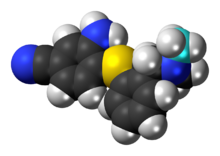Chemistry:DASB
 DASB (above) and [C-11]DASB | |
 Radioactive carbon atom marked in cyan | |
| Identifiers | |
|---|---|
| |
| CAS Number |
|
| PubChem CID | |
| ChemSpider | |
| UNII |
|
| Chemical and physical data | |
| Formula | C16H17N3S |
| Molar mass | 283.39 g·mol−1 |
| 3D model (JSmol) |
|
| |
| |
| | |
DASB, also known as 3-amino-4-(2-dimethylaminomethylphenylsulfanyl)-benzonitrile, is a compound that binds to the serotonin transporter. Labeled with carbon-11 — a radioactive isotope — it has been used as a radioligand in neuroimaging with positron emission tomography (PET) since around year 2000.[1] In this context it is regarded as one of the superior radioligands for PET study of the serotonin transporter in the brain,[2] since it has high selectivity for the serotonin transporter.[3]
The DASB image from a human PET scan shows high binding in the midbrain, thalamus and striatum, moderate binding in the medial temporal lobe and anterior cingulate, and low binding in neocortex. The cerebellum is often regarded as a region with no specific serotonin transporter binding and the brain region is used as a reference in some studies.[4]
Since the serotonin transporter is the target of SSRIs used in the treatment of major depression it has been natural to examine DASB binding in depressed patients. Several such research studies have been performed.[5]
There are a number of alternative PET radioligands for imaging the serotonin transporter: [11C]ADAM, [11C]MADAM, [11C]AFM, [11C]DAPA, [11C]McN5652, and [11C]-NS 4194. A related molecule to DASB, that can be labeled with fluorine-18, has also been suggested as a PET radioligand.[6] With single-photon emission computed tomography (SPECT) using the radioisotope iodine-123 there are further radioligands available: [123I]ODAM, [123I]IDAM, [123I]ADAM,[7] and [123I]β-CIT.[2] A few studies have examined the difference in binding between the radioligands in nonhuman primates,[8][9] as well as in pigs.[10]
Other compounds that can be labeled to work as PET radioligands for the study of the serotonin system are, e.g., altanserin and WAY-100635.
Methodological issues
The binding potential of DASB can be estimated with kinetic modeling on a series of brain scans.[11]
A test-retest reproducibility PET study indicates that [11C]DASB can be used to measure the serotonin transporter parameters with high reliability in receptor-rich brain regions.[4]
When the DASB neuroimages are analyzed the kinetic models suggested by Ichise and coworkers[12] can be employed to estimate the binding potential. A test-retest reproducibility experiment has been performed to evaluate this approach.[13]
Studies
Besides the studies listed below a few occupancy studies have been reported.[5]
| What | Result | Subjects | Ref. |
|---|---|---|---|
| 5-HTTLPR LALA serotonin transporter genotype | Increase in putamen | 43/30 | [14] |
| 5-HTTLPR LALA serotonin transporter genotype | Increase in midbrain | 19 | [15] |
| 5-HTTLPR LALA serotonin transporter genotype | No difference | 63 | [16] |
| Age | No effect found | ||
| Body mass index | Inverse correlation (?) | ? | [17] |
| Seasonality | Higher in winter in putamen and caudate | 54 | |
| Seasonality | Higher in fall and winter | 88 | |
| NEO PI-R Neuroticism | Positive correlation in thalamus | 31 males | |
| Disease | |||
| Depressed during major depressive episodes | No difference found | 20+20 | [18] |
| Depressed with highly negativistic "dysfunctional attitudes" during major depressive episodes | Increase in prefrontal cortex, anterior cingulate, thalamus, bilateral caudate, and bilateral putamen | 20(?)+20 | [18] |
| Recovered depressed patients | No difference found | 24+20 males | |
| Unipolar depression | Increase in thalamus, insula and striatum | 18+34 | [19] |
| Unmedicated unipolar major depression | Reduced 5-HTT availability in the thalamus |
</ref> | |
| TCI anxiety in unmedicated unipolar major depression | Reduced 5-HTT availability in the thalamus, midbrain and amygdala | [20] | |
| Bipolar depression | Increase in thalamus, insula and striatum | 18+34 | [19] |
| Bipolar depression | Decrease in midbrain, amygdala, hippocampus, thalamus, putamen, and anterior cingulate cortex | 18+41 | [21] |
| Obsessive compulsive disorder | Reduction and correlation with severity in thalamus and midbrain | 9+19 | [22] |
| Alcoholism | No significant alteration | 30 + 18 | [23] |
| Parkinson's disease | Reduction in forebrain | 5+8 | [24] |
| Non-depressed Parkinson's disease | Decreased binding in caudate, midbrain, putamen, orbitofrontal cortex and (non-significantly) dorsolateral prefrontal cortex | ||
| Depressed Parkinson's disease patients | Increase in prefrontal and dorsolateral cortices | 7+7 | |
| Drug/intervention | |||
| Abstinent MDMA ('Ecstasy') users | Global reduction | 23+19 | |
| Former MDMA users and polydrug users | No significant difference in brain regions examined | 12+9+19 | |
| Reduced synaptic serotonin (by rapid tryptophan depletion) | (small reduction in binding potential) | 8 | [25] |
| Lowering of brain serotonin (by acute tryptophan depletion) | No change observed | 25 (14) |
References
- ↑ "Imaging the serotonin transporter with positron emission tomography: initial human studies with [11C]DAPP and [11C]DASB". European Journal of Nuclear Medicine 27 (11): 1719–1722. November 2000. doi:10.1007/s002590000365. PMID 11105830.
- ↑ 2.0 2.1 "Neuroimaging of the Serotonin Transporter — Possibilities and Pitfalls". Current Psychiatry Reviews 2 (1): 111–149. February 2006. doi:10.2174/157340006775101508. http://www-bmu.psychiatry.cam.ac.uk/publications/brust06neu.pdf. Retrieved 2008-01-23.
- ↑ "In vitro and in vivo characterisation of [11C]-DASB: a probe for in vivo measurements of the serotonin transporter by positron emission tomography". Nuclear Medicine and Biology 29 (5): 509–515. July 2002. doi:10.1016/S0969-8051(02)00316-5. PMID 12088720.
- ↑ 4.0 4.1 "Estimation of serotonin transporter parameters with 11C-DASB in healthy humans: reproducibility and comparison of methods". Journal of Nuclear Medicine 47 (5): 815–826. May 2006. PMID 16644752. http://jnm.snmjournals.org/cgi/content/abstract/47/5/815.
- ↑ 5.0 5.1 "Imaging the serotonin transporter during major depressive disorder and antidepressant treatment". Journal of Psychiatry & Neuroscience 32 (2): 86–102. March 2007. PMID 17353938.
- ↑ "3-Amino-4-(2-((4-[18F]fluorobenzyl)methylamino)methylphenylsulfanyl)benzonitrile, an F-18 fluorobenzyl analogue of DASB: synthesis, in vitro binding, and in vivo biodistribution studies". Bioconjugate Chemistry 18 (5): 1612–1618. September–October 2007. doi:10.1021/bc070112g. PMID 17705553.
- ↑ "2-((2-((dimethylamino)methyl)phenyl)thio)-5-iodophenylamine (ADAM): an improved serotonin transporter ligand". Nuclear Medicine and Biology 27 (3): 249–254. April 2000. doi:10.1016/s0969-8051(00)00084-6. PMID 10832081.
- ↑ "Comparison of (+)-(11)C-McN5652 and (11)C-DASB as serotonin transporter radioligands under various experimental conditions". Journal of Nuclear Medicine 43 (5): 678–692. May 2002. PMID 11994534. PMC 2078607. http://jnm.snmjournals.org/cgi/content/abstract/43/5/678.
- ↑ "Comparative evaluation in nonhuman primates of five PET radiotracers for imaging the serotonin transporters: [11C]McN 5652, [11C]ADAM, [11C]DASB, [11C]DAPA, and [11C]AFM". Journal of Cerebral Blood Flow and Metabolism 22 (11): 1377–1398. November 2002. doi:10.1097/00004647-200211000-00011. PMID 12439295.
- ↑ "[11C]-NS 4194 versus [11C]-DASB for PET imaging of serotonin transporters in living porcine brain". Synapse 49 (3): 170–177. September 2003. doi:10.1002/syn.10222. PMID 12774301.
- ↑ "Positron emission tomography quantification of [(11)C]-DASB binding to the human serotonin transporter: modeling strategies". Journal of Cerebral Blood Flow and Metabolism 21 (11): 1342–1353. November 2001. doi:10.1097/00004647-200111000-00010. PMID 11702049.
- ↑ "Linearized reference tissue parametric imaging methods: application to [11C]DASB positron emission tomography studies of the serotonin transporter in human brain". Journal of Cerebral Blood Flow and Metabolism 23 (9): 1096–1112. September 2003. doi:10.1097/01.WCB.0000085441.37552.CA. PMID 12973026.
- ↑ "PET imaging of serotonin transporters with [11C]DASB: test-retest reproducibility using a multilinear reference tissue parametric imaging method". Journal of Nuclear Medicine 47 (2): 208–214. February 2006. PMID 16455625.
- ↑ "Novel 5-HTTLPR allele associates with higher serotonin transporter binding in putamen: a [(11)C] DASB positron emission tomography study". Biological Psychiatry 62 (4): 327–331. August 2007. doi:10.1016/j.biopsych.2006.09.022. PMID 17210141.
- ↑ "Midbrain serotonin transporter binding potential measured with [11C]DASB is affected by serotonin transporter genotype". Journal of Neural Transmission 114 (5): 635–639. May 2007. doi:10.1007/s00702-006-0609-0. PMID 17225932.
- ↑ "Serotonin transporter polymorphisms (SLC6A4 insertion/deletion and rs25531) do not affect the availability of 5-HTT to [11C] DASB binding in the living human brain". NeuroImage 52 (1): 50–54. August 2010. doi:10.1016/j.neuroimage.2010.04.032. PMID 20406689.
- ↑ "Inverse correlation between body mass index and serotonin transporter binding in human brain: A [11C]DASB PET study". NeuroImage 2, supplement 2: T161. 2008. doi:10.1016/j.neuroimage.2008.04.128. Neuroreceptor Mapping 2008, The Seventh International Symposium on Functional Neuroreceptor Mapping of Living Brain
- ↑ 18.0 18.1 Cite error: Invalid
<ref>tag; no text was provided for refs namedMeyerJ2004Brain - ↑ 19.0 19.1 "Elevated serotonin transporter binding in major depressive disorder assessed using positron emission tomography and [11C]DASB; comparison with bipolar disorder". Biological Psychiatry 62 (8): 870–877. October 2007. doi:10.1016/j.biopsych.2007.03.016. PMID 17678634.
- ↑ Cite error: Invalid
<ref>tag; no text was provided for refs namedReimoldM2008Anxiety - ↑ "Brain serotonin transporter binding in depressed patients with bipolar disorder using positron emission tomography". Archives of General Psychiatry 64 (2): 201–208. February 2007. doi:10.1001/archpsyc.64.2.201. PMID 17283287.
- ↑ "Reduced availability of serotonin transporters in obsessive-compulsive disorder correlates with symptom severity - a [11C]DASB PET study". Journal of Neural Transmission 114 (12): 1603–1609. December 2007. doi:10.1007/s00702-007-0785-6. PMID 17713719.
- ↑ "PET [11C]DASB imaging of serotonin transporters in patients with alcoholism". Alcoholism: Clinical and Experimental Research 31 (1): 28–32. January 2007. doi:10.1111/j.1530-0277.2006.00261.x. PMID 17207098.
- ↑ "Spared caudal brainstem SERT binding in early Parkinson's disease". Journal of Cerebral Blood Flow and Metabolism 28 (3): 441–444. March 2008. doi:10.1038/sj.jcbfm.9600599. PMID 18073772.
- ↑ "Effects of reduced endogenous 5-HT on the in vivo binding of the serotonin transporter radioligand 11C-DASB in healthy humans". Synapse 55 (3): 164–175. March 2005. doi:10.1002/syn.20105. PMID 15605360.
 |

